


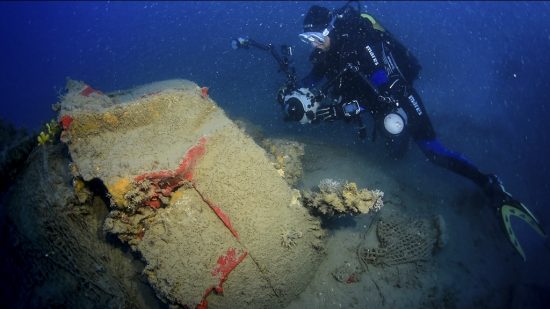
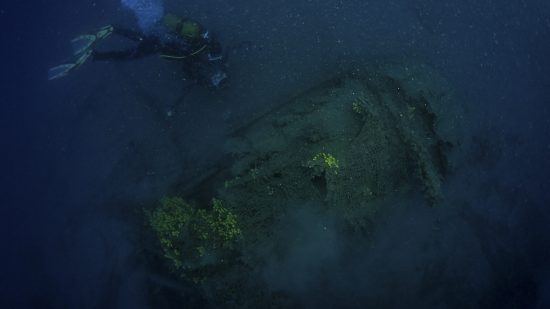
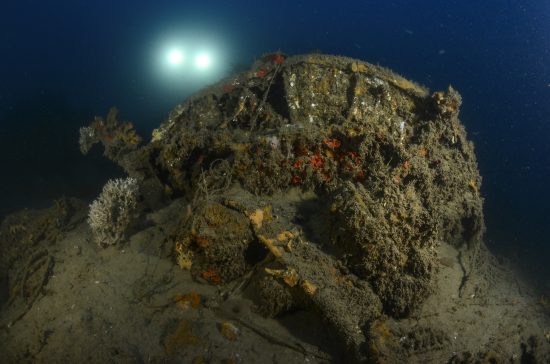
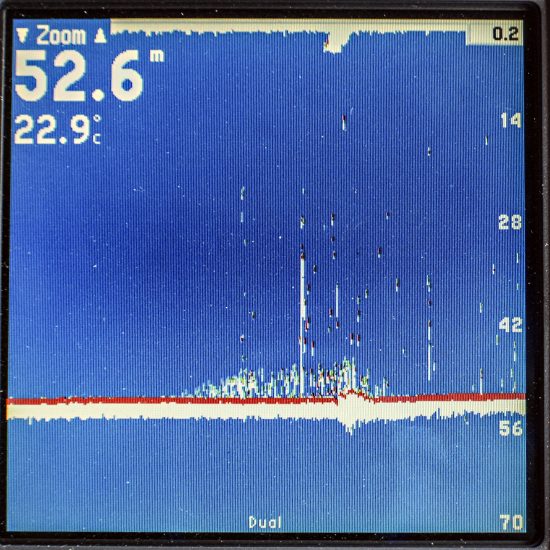
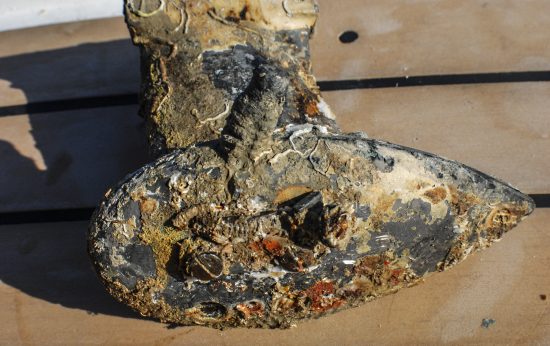
On August 31, 2008, when a group of divers touched the sea bottom at a depth of 54 meters in front of Čanj, it was once again confirmed that the Montenegrin seabed hides many unknown secrets. The divers aimed at finally determining whether or not the small irregularities that had been read on sonar were a natural reef rising from the seabed, or an object that was the work of human hands. The wreck of the twin-engine plane they found was not only a significant discovery, because nothing was previously known about the crash of this aircraft, but also because it was the best-preserved airplane wreck found so far in Montenegrin waters.
Based on local testimonies, the only plane that crashed into the sea in this area at the end of the Second World War was an Italian "Savoy" aircraft. Its wings fell off when it hit the water, so it is assumed that the petrified airplane wing, which is at the bottom, much shallower and closer to the shore, belongs to it. As the found wreck had both wings, it immediately became clear that it was another plane, a wreck for which there is no data, neither written nor verbal.
Based on the first measurements and recordings made by the team, experts from the Aviation Museum in Belgrade unequivocally determined that it was a very widespread aircraft of the German manufacturer JUNKERS from the 88 series. The plane lies upside down, with both wings above the muddy bottom. The entire wreck is in one piece, with the exception of the tail part which, together with the horizontal stabilizers, most likely fell off during the landing of the aircraft on the water. It is certain that this tail part is also located somewhere near the location, probably closer to the place where first contact with the water was made. Due to its wingspan of 20 meters, it is very possible that during the sinking, the fuselage of the plane "sailed" through the water, until it finally landed on the seabed. In the central part of each wing, there are two large engines, partially sunk in the mud. Their propellers were wooden, so they did not manage to stay on their shaft, either after hitting the water or after spending six decades on the seabed where they were "plowed" by fishing boats. Less than a year after the discovery of the plane, the same team noticed that the complete left engine was pulled out of the wing and turned at an angle of 90 degrees towards the fuselage. After announcing the discovery of the plane, fishermen probably intensified their actions at this location, and after more than six decades, for the first time, they seriously damaged the plane with strong nets.
At the time of writing this blog, no details are known about the history of the aircraft, its crew, nor the circumstances under which it reached the bottom. The nose of the plane was most likely shattered when it hit the water, withstanding the force of the accident for the most part. In addition to the standard cockpit, this type of aircraft also had a glass dome on the bow, of which nothing remains. As it was turned upside down, it is difficult to determine the extent to which the cockpit has been preserved, as well as whether or not the remains of someone from the crew are in the plane. The lower part of the plane, which is facing the surface, is largely drilled by poacher's dynamite, evidenced by numerous skeletons of large crowns that can be found near the wreck. Unlike the "Spitfire" in front of Herceg Novi, which owed its performance to an extremely light construction and materials, this aircraft has extremely strong aluminum armor which has withstood the test of time. This was probably the reason why, unlike the Spitfire which disintegrated into almost unrecognizable pieces during the crash, the Junkers 88 retained its recognizable shape until today, as well as the astonishing preservation of certain details of the aircraft.
Crucial to identify: wing span and bomb carrier
After the first dives on the newly discovered wreck, which took place in a rather euphoric mood, we considered it necessary to conduct research that would be important for identifying the aircraft. The initial suspicion that it was a British Bristol Beoufighter in the sea in front of Čanj was dismissed when the engine shots were carefully looked at. With experts from the Aviation Museum in Belgrade, Aleksandar Kol and Dragan Munizab, we found that the engines were in-line, not star as we initially thought. According to the characteristic exhausts, we concluded that it could have German Jumo engines. Confirmation that this was an aircraft of the once powerful Luftwaffe was obtained by finding a very specific, aerodynamic part which only slightly protruded from the mud under the wing. The word "Fest" was clearly visible on it, meaning "strong" in German. Again, experts from the Aviation Museum helped, sending us original photos that clearly show the bomb carrier on Junkers 88, which completely matched what we had found. Final confirmation was obtained by measuring the wingspan, which is characteristic for each type of aircraft. Its wing span was exactly 20.25 meters, which matched the technical characteristics of the Yu 88. With its yellow-painted wing ends (which was a feature of German aircraft on the Balkan battlefield), it became certain that this was a German plane.
In search of historical data
The identification of the plane is certainly a big step, but now it is time to search for the serial numbers of the aircraft and gather information about its fate. What was the mission, who were the crew members, was the plane shot down or forced to land in the sea due to a malfunction? These are just some of the questions waiting to be answered.
At the end of January 2010, we met in Kraljevica, near Rijeka, with the well-known underwater explorer and expert in world aviation, Daniel Frk. In an exchange of information, we came across a famous list of planes lost in the Second World War in the former Yugoslavia. In Daniel's study, the data that fans of aviation history have been collecting for years were before my eyes. Of course, the solution was not so simple. In the period 1941–1943, no Junkers 88 planes fell into the sea along the coast of Montenegro. At least, it was not recorded anywhere. There were a lot of them destroyed on the ground, knocked down, falling over the mainland, but no information mentioned a plane in front of Čanj. Hope was awakened by the fact that two Junkers 88, under the P4BA designations (lost on June 29, 1941) and 4MEH (lost on July 5, 1941) are listed as missing and there is no other information about them. A further search for data that could shed new light on the plane near Čanj will be directed towards finding the tail of the plane and some markings on the aircraft itself.
Diving suitability ratings
This aircraft lies at a depth of 54 meters, which is a depth safely available only to technical divers. Standard problems such as locating the small wreck, its distance from the shore, anchoring at great depth in a muddy bottom, as well as the strong currents constantly present in this place, are not benefits of diving in this location. However, the unique visual and adrenaline experience that the wreck of the German war bomber provides, makes diving here an unforgettable experience for every diver. With good visibility, during 10-15 minutes spent at the bottom, it is possible to see the plane from all angles, its various details and sea inhabitants, such as lobsters and groupers, which the wreck abounds in. It is by no means recommended to touch any part of the aircraft, as it has not yet been determined whether the bomber released its explosive cargo before sinking.
For more diving information, see: Zeljko Dragutinovic www.divemontenegro.com
Written by: Dušan Varda and Janez Kranjc
Photos by Ivana OK, Janez Kranjc and archive images
 Ivana and Janez
Ivana and Janez 21st July 2020
21st July 2020